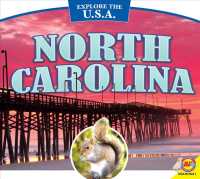- ホーム
- > 洋書
- > 英文書
- > Science / Mathematics
Full Description
Engineering Design and Graphics with SolidWorks 2023
In Engineering Design and Graphics with SolidWorks 2023, award-winning CAD instructor and author James Bethune shows students how to use SolidWorks to create engineering drawings and designs. The textbook has been updated to cover the new features in SolidWorks 2023. It focuses on the creation of engineering drawings, including dimensions and tolerances and the use of standard parts and tools. Each chapter contains step-by-step sample problems that show students how to apply the concepts presented in the chapter.
Effective pedagogy throughout the text helps students learn and retain concepts:
Objectives: Each chapter begins with objectives and an introduction to the material.
Summaries: Each chapter concludes with a summary and exercise problems.
Numerous Illustrations: The multitude of illustrations, accompanied by explanatory captions, present a visual approach to learning. Students see in the text what they see on the screen with the addition of explanatory text.
Practical Application: The text provides hundreds of exercise projects of varying difficulty (far more than any other computer graphics text). These exercises reinforce each chapter's content and help students learn by doing.
Flexibility: With the hundreds of problems presented in the book, instructors can assign different problems within the same class and from year to year without repeating problems for students.
Meets Standards: The text teaches ANSI standards for dimensions and tolerances. This helps students understand how their designs are defined for production and the importance of proper tolerancing.
Step-by-Step Approach: In presenting the fundamentals of engineering drawing using SolidWorks, the text uses a step-by-step approach that allows students to work and learn at their own pace
Contents
Preface
Chapter 1 Getting Started
Chapter Objectives
1-1 Introduction
1-2 Starting a New Document
1-3 SolidWorks Colors
1-4 Creating a Fully Defined Circle
1-5 Units
1-6 Rectangle
1-7 Moving Around the Drawing Screen
1-8 Orientation
1-9 Sample Problem SP1-1
1-10 Creating 3D Models
1-11 Saving Documents
1-12 Sample Problem SP1-2
1-13 Holes
Chapter Project
Chapter 2 Sketch Entities and Tools
Chapter Objectives
2-1 Introduction
2-2 Mouse Gestures and the S Key
2-3 Origins
2-4 Circle
2-5 Rectangle
2-6 Slots
2-7 Perimeter Circle
2-8 Arcs
2-9 Polygons
2-10 Spline
2-11 Ellipse
2-12 Fillets and Chamfers
2-13 Sketch Text
2-14 Point
2-15 Trim Entities
2-16 Extend Entities
2-17 Offset Entities
2-18 Mirror Entities
2-19 Linear Sketch Pattern
2-20 Circular Sketch Pattern
2-21 Move Entities
2-22 Copy Entities
2-23 Rotate Entities
2-24 Scale Entities
2-25 Stretch Entities
2-26 Split Entities
2-27 Jog Lines
2-28 Centerline
2-29 Sample Problem SP2-1
2-30 Sample Problem SP2-2
2-31 Sample Problem SP2-3
Chapter Projects
Chapter 3 Features
Chapter Objectives
3-1 Introduction
3-2 Extruded Boss/Base
3-3 Sample Problem SP3-1
3-4 Extruded Cut
3-5 Hole Wizard 3-6 Creating a Hole with the Circle and Extruded Cut Tools
3-7 Blind Holes
3-8 Fillet
3-9 Chamfer
3-10 Revolved Boss/Base
3-11 Revolved Cut
3-12 Reference Planes
3-13 Lofted Boss/Base
3-14 Shell
3-15 Swept Boss/Base
3-16 Draft
3-17 Linear Sketch Pattern
3-18 Circular Sketch Pattern
3-19 Mirror
3-20 Helix Curves and Springs
3-21 Compression Springs
3-22 Torsional Springs
3-23 Extension Springs
3-24 Wrap
3-25 Editing Features
3-26 Sample Problem SP3-2
3-27 Sample Problem SP3-3
3-28 Curve Driven Patterns
Chapter Projects
Chapter 4 Orthographic Views
Chapter Objectives
4-1 Introduction
4-2 Third- and First-Angle Projections
4-3 Fundamentals of Orthographic Views
4-4 Drawing Orthographic Views
4-5 Section Views
4-6 Drawing a Section View
4-7 Aligned Section Views
4-8 Broken Views
4-9 Detail Views
4-10 Auxiliary Views
4-11 First-Angle Projection
Chapter Projects
Chapter 5 Assemblies
Chapter Objectives
5-1 Introduction
5-2 Starting an Assembly
5-3 Move Component
5-4 Rotate Component
5-5 Mouse Gestures for Assemblies
5-6 Mate
5-7 Bottom-up Assemblies
5-8 Creating an Exploded Isometric Assembly
5-9 Creating an Exploded Isometric Drawing
5-10 Assembly Numbers
5-11 Bill of Materials (BOM or Parts List)
5-12 Title Blocks
5-13 Animate Collapse
5-14 Sample Problem SP5-1
5-15 Using the Motion Study Tool
5-16 Editing a Part Within an Assembly 5-17 Interference Detection/ClearanceVerification
Chapter Projects
Chapter 6 Threads and Fasteners
Chapter Objectives
6-1 Introduction
6-2 Thread Terminology
6-3 Thread Callouts—ANSI Metric Units
6-4 Thread Callouts—ANSI Unified Screw Threads
6-5 Thread Representations
6-6 Internal Threads—Inches
6-7 Threaded Blind Holes—Inches
6-8 Internal Threads—Metric
6-9 Accessing the Design Library
6-10 Thread Pitch 6-11 Determining an External ThreadLength—Inches
6-12 Smart Fasteners
6-13 Determining an Internal Thread Length
6-14 Set Screws 6-15 Drawing a Threaded Hole in the Sideof a Cylinder
6-16 Adding Set Screws to the Collar
Chapter Projects
Chapter 7 Dimensioning
Chapter Objectives
7-1 Introduction
7-2 Terminology and Conventions—ANSI
7-3 Adding Dimensions to a Drawing
7-4 Drawing Scale
7-5 Units
7-6 Dimensioning Holes and Fillets
7-7 Dimensioning Counterbored and Countersunk Holes
7-8 Angular Dimensions
7-9 Ordinate Dimensions
7-10 Baseline Dimensions
7-11 Locating Dimensions
7-12 Fillets and Rounds
7-13 Rounded Shapes—Internal
7-14 Rounded Shapes—External
7-15 Irregular Surfaces
7-16 Polar Dimensions
7-17 Chamfers
7-18 Symbols and Abbreviations
7-19 Symmetrical and Centerline Symbols
7-20 Dimensioning to a Point
7-21 Dimensioning Section Views
7-22 Dimensioning Orthographic Views
Chapter Projects
Chapter 8 Tolerancing
Chapter Objectives
8-1 Introduction
8-2 Direct Tolerance Methods
8-3 Tolerance Expressions
8-4 Understanding Plus and Minus Tolerances
8-5 Creating Plus and Minus Tolerances Adding Plus and Minus Symmetric Tolerances Using the Dimension Text Box
8-6 Creating Limit Tolerances
8-7 Creating Angular Tolerances
8-8 Standard Tolerances
8-9 Double-Dimensioning Errors 8-10 Chain Dimensions and Baseline Dimensions
8-11 Tolerance Studies
8-12 Rectangular Dimensions
8-13 Hole Locations
8-14 Choosing a Shaft for a Toleranced Hole
8-15 Sample Problem SP8-1
8-16 Sample Problem SP8-2
8-17 Nominal Sizes
8-18 Standard Fits (Metric Values)
8-19 Standard Fits (Inch Values)
8-20 Preferred and Standard Sizes
8-21 Surface Finishes
8-22 Surface Control Symbols
8-23 Applying Surface Control Symbols
8-24 Design Problems
8-25 Geometric Tolerances
8-26 Tolerances of Form
8-27 Flatness
8-28 Straightness
8-29 Straightness (RFS and MMC)
8-30 Circularity
8-31 Cylindricity
8-32 Geometric Tolerances Using SolidWorks
8-33 Datums
8-34 Tolerances of Orientation
8-35 Perpendicularity
8-36 Parallelism
8-37 Angularity
8-38 Profiles
8-39 Runouts
8-40 Positional Tolerances
8-41 Creating Positional Tolerances
8-42 Virtual Condition
8-43 Floating Fasteners
8-44 Sample Problem SP8-3
8-45 Sample Problem SP8-4
8-46 Fixed Fasteners
8-47 Sample Problem SP8-5
8-48 Design Problems
Chapter Projects
Chapter 9 Bearings and Fit Tolerances
Chapter Objectives
9-1 Introduction
9-2 Sleeve Bearings
9-3 Bearings from the Toolbox
9-4 Ball Bearings
9-5 Fits and Tolerances for Bearings
9-6 Fits—Inches
9-7 Clearance Fits
9-8 Hole Basis
9-9 Shaft Basis
9-10 Sample Problem SP9-1
9-11 Interference Fits
9-12 Manufactured Bearings
9-13 Fit Tolerances—Millimeters
Chapter Projects
Chapter 10 Gears
Chapter Objectives
10-1 Introduction
10-2 Gear Terminology
10-3 Gear Formulas
10-4 Creating Gears
10-5 Gear Ratios
10-6 Gears and Bearings
10-7 Power Transmission—Shaft to Gear
10-8 Set Screws and Gear Hubs
10-9 Keys, Keyseats, and Gears
10-10 Sample Problem SP10-1
10-11 Rack and Pinion Gears
10-12 Metric Gears
Chapter Projects
Chapter 11 CSWA Preparation
Chapter Objectives
11-1 Introduction
11-2 Working with Cubes
11-3 Drawing Profiles
11-4 Drawing Small 3D Objects
11-5 Drawing Larger Objects
11-6 Drawing Auxiliary Views
11-7 Drawing Break Views
11-8 Drawing Section Views
11-9 Drawing Detail Views
11-10 Drawing Lines and Views
11-11 Creating Assemblies
11-12 Problem Answers
Appendix
9780137899524 TOC 2/2/2023








